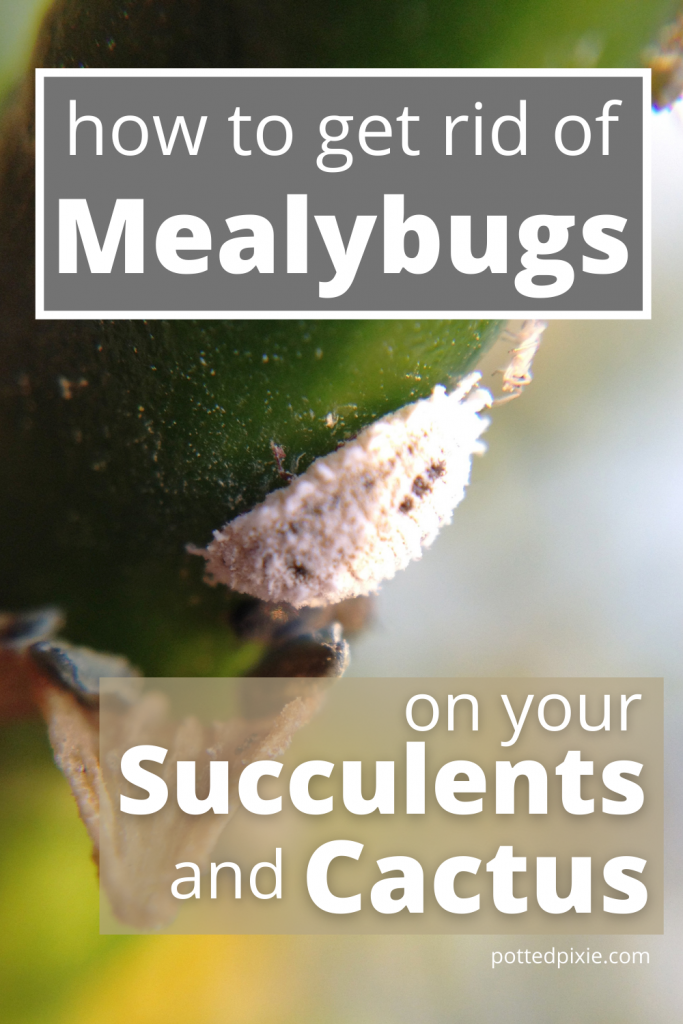Those white spots on your cactus are called mealybugs.
There are a few ways to get rid of them depending on the level of infestation – you will either need to scrape them off one by one, spray on rubbing alcohol or soapy water and oil, use a systemic insecticide, or a combination of all 3.
Mealy bugs are about the size of a pinhead, look like little white cotton fluff and seem to appear quickly and out of nowhere.
You do not want these little pests to live on your beloved houseplants for very long.
Here’s everything you need to know about getting rid of mealybugs on your cactus (will work on succulents, too).
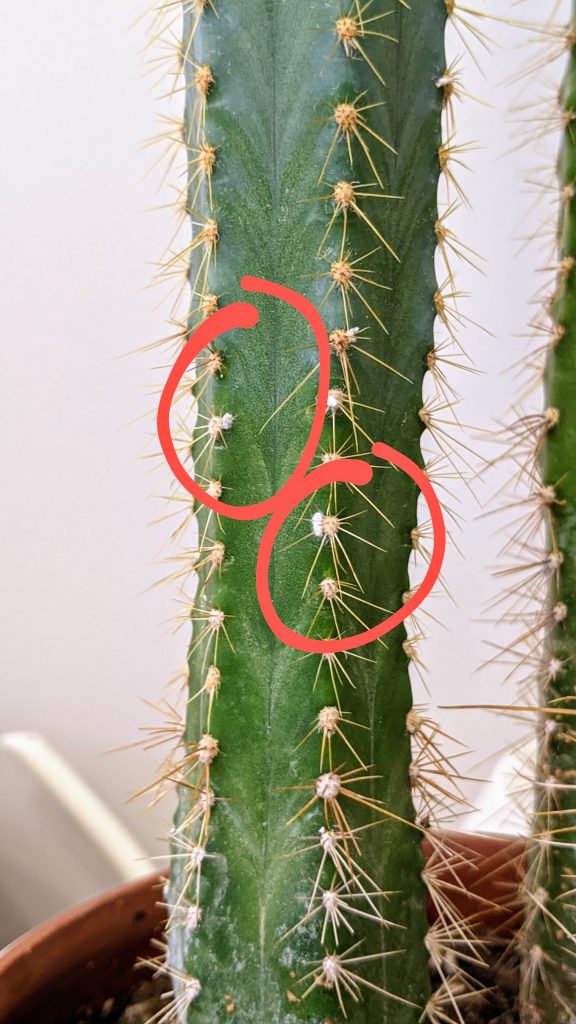
This post contains affiliate links, which means I may make a small commission if you click through and make a purchase.
What Are Mealybugs and Where Do They Come From?
Mealybugs are small bugs attracted to indoor houseplants, mainly succulents, cacti and some tropical plants.
They are one of the most common types of houseplant pests.
They feed off the juices of your plant which will weaken it, stunt its growth and eventually kill it with enough time.
Once you see for yourself or look at a few pictures of mealybugs on plants, you will know how to easily identify them.

Mealybugs usually start when a new plant is brought home that was already carrying some bugs or eggs. So it’s very important that you inspect your cactus before you bring it into the house to ensure it’s bug-free.
A mealybug infestation can also start from many other things. They are present in our environment and can be brought in by humans, pets or even cut from flowers from your garden.
While they’re pretty gross looking little bugs, the good news is that mealybugs are not harmful to humans and they won’t bite you or crawl on you and they won’t infest your house.
Signs of Mealybugs on Your Cactus or Succulent
The most obvious signs of mealybugs on your plant is when there are a bunch of white spots or little white fuzz pieces attached to your cactus. You will have to get up close to your plant to confirm.
You will know you have mealybugs if you see white fuzz dotted all over your cactus.
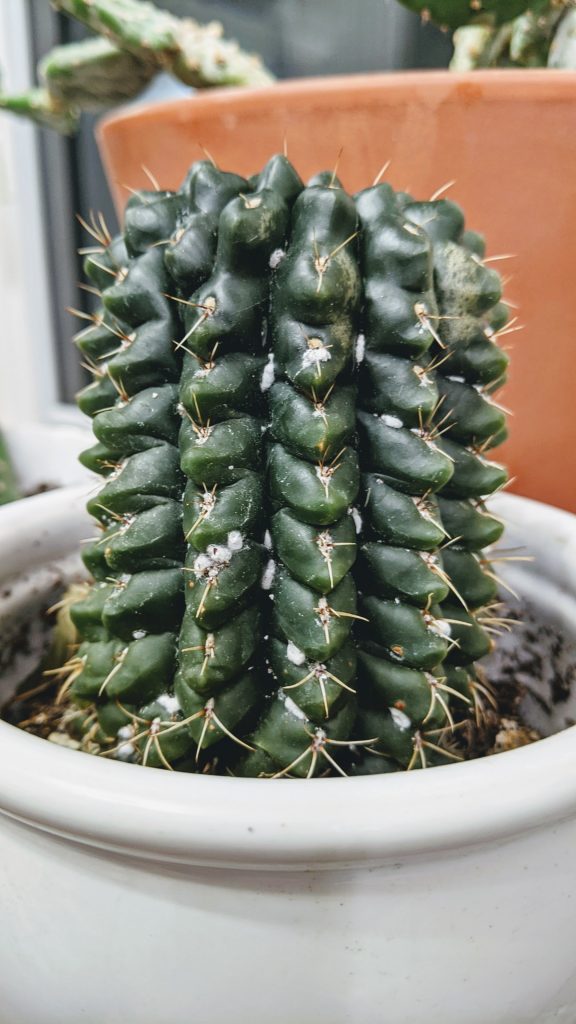
By the time you notice this, it will likely be accompanied by areas that look shiny or wet (from their excretions) or worse, the development of sooty mold or fungus. This is the result from the honeydew that the bugs produce.
Another sign that mealybugs are present in your soil or at the base of your plant is if there are spots in your soil that look wet, even though you haven’t watered it.
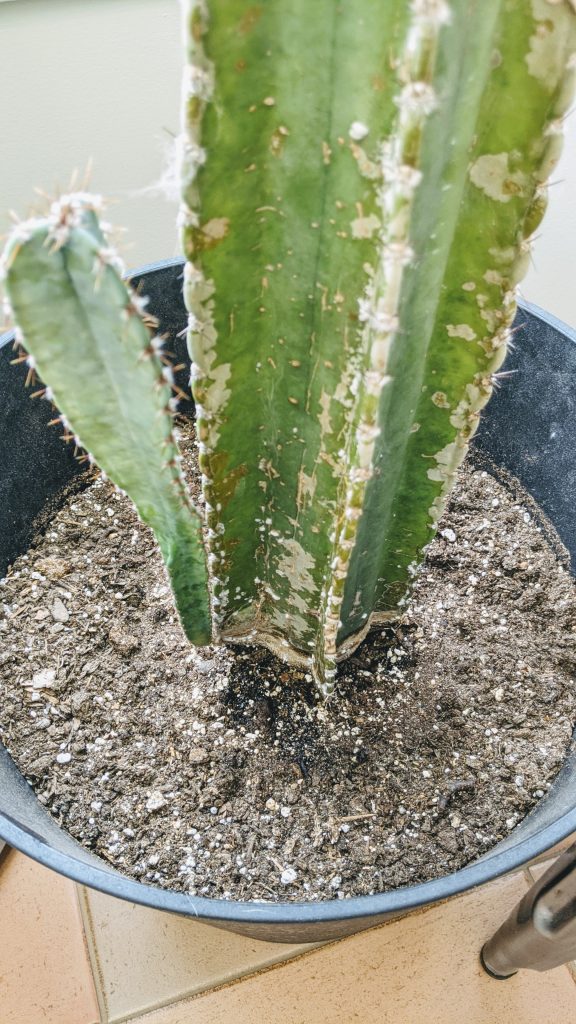
Your cactus may start to look generally less healthy, start turning yellow or brown, and start to lean to one side.
Upon closer inspection, at their largest, mealybugs are about the size of a pinhead and can be seen with the naked eye up close.
Before they settle in and get comfortable, these little cactus bugs can be identified by their dull-grey color and and lined back (almost like a hasselback potato).
Once they find the perfect spot and get comfy, they produce a barrier around themselves for protection and to lay their eggs. This looks like little specks of cotton fluff.
Some types of male mealybugs can fly, but most spread by crawling from one plant to another.
Therefore, they can spread much faster if you have many plants close together or have touching foliage.
Chances are, if you have white spots on your cactus or little dots that look like white bugs, they are mealybugs.
How to Get Rid of Mealybugs on Your Cactus
If you’ve caught the mealybugs early before they have multiplied, you can pick them off easily.
Dip a q-tip in 70% strength rubbing alcohol and scrape the mealy bug off your cactus.
Check every inch of the plant to make sure. Inspect the plant again each day for a few more days to ensure no more bugs have appeared.
Repeat the same step with a q-tip each time you see one.
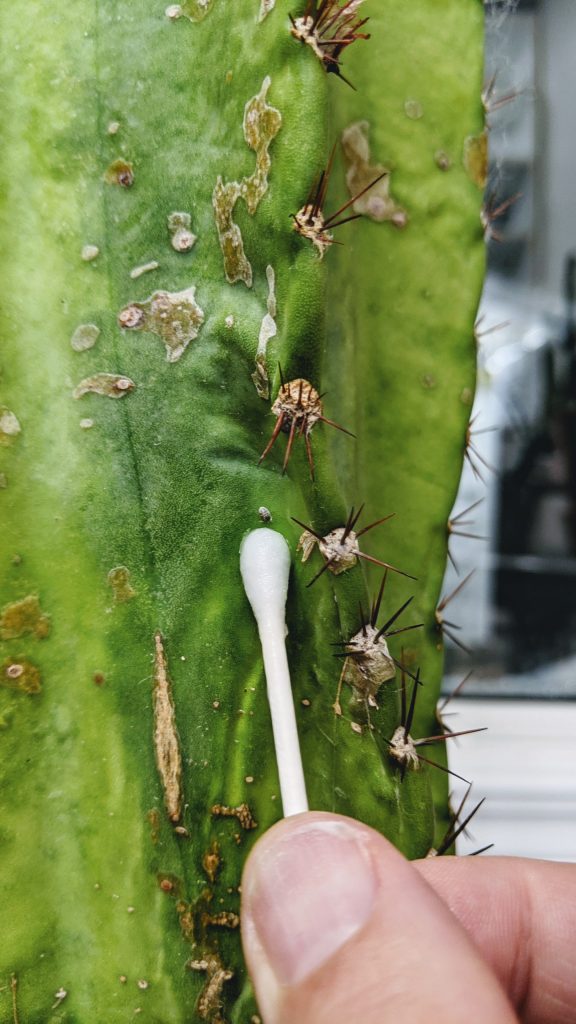
Use a new side of the q-tip for each mealybug, as you want to prevent unnecessary spreading.
If you have a larger infestation of mealybugs that cannot be scrapped off one by one, you will have to spray your plant.
It could take up to 3 or 4 weeks to get rid of mealybugs.
You will have to repeat treatment several times to kill these pests in all stages before you will be able to get rid of them completely.
Using a Homemade Dish Soap Spray
Another method is to make your own mealybug killer spray using ingredients you likely already have on hand.
Mix up dish soap and distilled or bottled water into a spray bottle.
If you can get your hands on neem oil, add this to the mixture for a much higher success rate.
Neem oil will provide a protective layer on your plant and make it harder for the bugs to eat through it.
Use about 3 times as much neem oil as dish soap.
I have had the best success with Blue Dawn dish soap and use a ratio of 2% soap to water.
For example, my spray bottle is 650ml (about 20 oz) so I used 13ml (about half an ounce) of dish soap and filled the rest with water.
You want to use distilled or bottled water so that the minerals in your tap water don’t benefit the mealybugs.
Spray this mixture directly on to the surface of your cactus everywhere, as these tiny critters can hide in nooks and crannies and you don’t want to miss any.
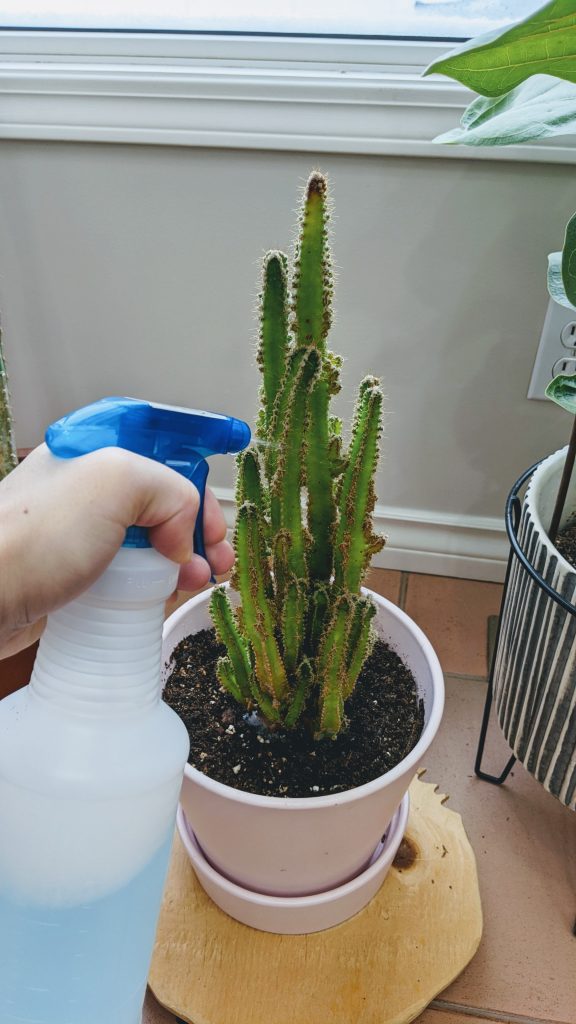
The soap with suffocate the bugs and the water will drown them out.
Repeat again in a couple days if you still see some remaining bugs. Once the bugs are all gone, mist the cactus with distilled water (no soap this time) to clean off any soap residue.
Using the dish soap method, your mealybugs should be gone after 2 weeks.
Don’t go overboard with the soapy water spray, as dish soap is still a detergent and can be damaging to your houseplant in high doses.
Use 70% Isopropyl Alcohol
Killing mealybugs with isopropyl alcohol is usually the most effective way to get rid of mealybugs bugs on your cactus.
Use 70% isopropyl alcohol (more commonly known as rubbing alcohol) in a spray bottle and spray every bug and white fuzz spot you see.
Do not use 90% strength as the alcohol will flash off too quickly and therefore won’t be as effective.
And if you choose this method, make sure your plant is away from direct sunlight or hot sun so that it doesn’t burn. Ideally, spray in the morning or evening.
The isopropyl alcohol virtually dries out the mealybugs on contact and makes them die almost immediately. Just like the soap water method, this will only work if you spray every single bug you see.
That being said, don’t go crazy with the alcohol, as too much of it can damage the plant.
If you’ve caught them early and you’re sure that there are only a small amount of bugs, it would be better to dip a q-tip in the isopropyl alcohol and kill the mealybugs one by one.
It can be difficult to get your hands on isopropyl alcohol these days, so if you can’t find any, try the dish soap and neem oil method first.
I wouldn’t recommend using hand sanitizer to get rid of mealybugs as there’s likely other ingredients that could be harmful to your plant.
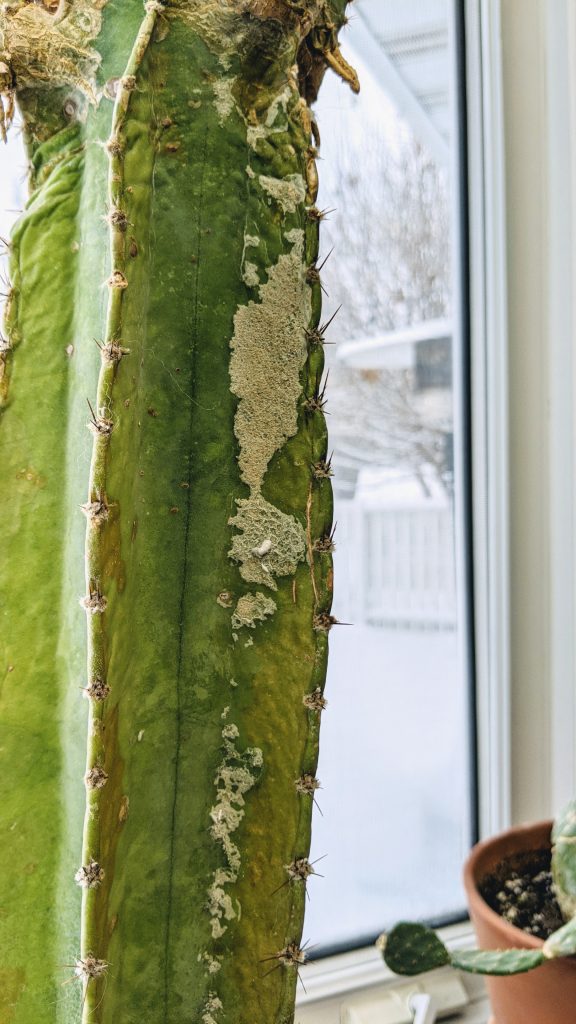
Systemic Insecticide Spray
Finally, you can visit your local garden centre or greenhouse and purchase a systemic insecticide (bonide granules) to kill the mealybugs from the inside out. The juices become toxic to mealybugs.
Basically, you will use the insecticide with water when you water your cactus, and it acts almost like an antibiotic instead of a topical solution like the other two methods.
To get rid of mealybugs for good, I recommend using a spray (whether it’s the soap mixture or rubbing alcohol) combined with the systemic insecticide.
This is because you can still have mealybugs living in your soil, so it’s best to target them from all angles.
Ideally, if you can, re-pot your plant with new soil to make sure there are no remaining bugs or eggs.
Other Methods That Might Get Rid of Mealybugs
If you have mealy bugs on your outdoor cacti, you could try going the natural route and introduce other bugs who will eat up the mealybugs.
Ladybugs will eat them up and Green Lacewings larvae feed on mealybugs as well as aphids.
Some people even bake their soil in the oven to kill off bugs, larvae and any other pathogens.
If you have a small amount of soil, you can sterilize it by placing it on a baking sheet and baking it in the oven at about 175 – 200 degrees Fahrenheit for about 45 minutes.
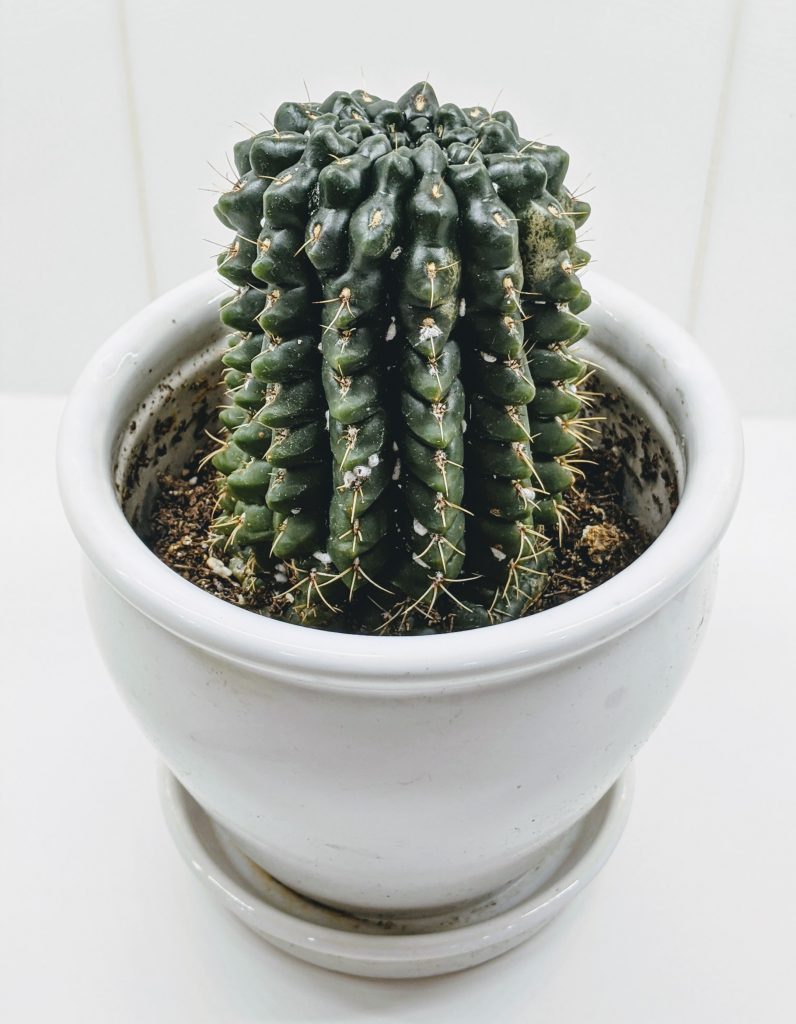
How to Prevent Mealybugs from Calling Your Cactus Home
The good news is that there are things you can do to prevent mealybugs from infesting your cacti, succulents and other houseplants.
The best way to prevent mealybugs is to not bring outdoor plants into your home where your indoor cacti reside.
If you do bring them inside, thoroughly inspect it for any sign of mealybugs before you put it nearby your other established plants.
If you want to be extra precautious, quarantine any new plants in your house away from the other for 2-3 weeks to be sure there were no signs of eggs or bugs.

Be careful not to over fertilize your indoor houseplants, as mealybugs will thrive on nitrogen rich soil.
If you are overfertilizing, your plant will have yellow-ing or burnt looking foliage, will stop growing and there may be a crust left over from the fertilizer.
Unfortunately, there is no guaranteed way to 100% prevent mealybugs.
That being said, I went years (more than a decade) of owning houseplants and cacti before I encountered these pests, so don’t worry too much!
Have you tried these methods? What works best for you? I’m curious – Leave a comment below!
More Cactus Posts:
53 Cute Cactus Names Based on Pop Culture Characters
How to Choose the Best Type of Pot for Your Cactus for Optimal Health
6 Reasons Your Cactus is Turning Brown & How to Fix it Fast
Stay Green!
